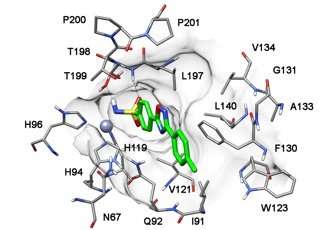Chemists have created compounds that can treat glaucoma

Glaucoma is a serious disease associated with increased intraocular pressure, often leading to blindness. One treatment is to reduce aqueous humour secretion in the ciliary body of the eye by inhibiting the activity of special enzymes called carbonic anhydrases. Russian scientists from RUDN University have designed new compounds that can effectively reduce intraocular pressure by isoform selective inhibiting human carbonic anhydrase. The results of the study have been published in Bioorganic Chemistry.
The study is focused on benzenesulfonamide derivatives containing a 1,2,4-oxadiazole moiety. "It was the first time that these compounds were considered as potential inhibitors of human carbonic anhydrase. Managing the enzyme's activity in ciliary processes using this compound, we can normalize the intraocular pressure," says Anton Shetnev, one of the authors of the paper from RUDN University.
Carbonic anhydrases comprise a family of widespread enzymes that facilitate CO2-bicarbonate interconversion in all tissues of human body. Their function is to catalyze the reversible hydration of carbon dioxide, which produces bicarbonate anion and a proton. This simple biochemical reaction is central to regulating pH in the intra- and extracellular space in various tissues and organs. It should be noted that carbonic anhydrase in performed by 15 isoforms (isoenzymes) localized in various tissues and slightly differing in the active site architecture. Sulfonamide-based inhibitors bind to the prosthetic zinc-ion in the catalytic cavity, thus suppressing activity of the enzyme, which can be described as a "key-lock" interaction. Most known carbonic anhydrase inhibitors can be compared to a master key which opens any lock-enzyme (all isoforms) of the corresponding family.
Since the affinity is non-selective (that is, there is no key thread exactly entering the grooves), such an agent might cause plenty of undesired effects. When developing a drug candidate, either potency of selectivity of the inhibitor are crucial. The latter could be achieved by designing sulfonamide-incorporating small molecules bearing appropriate molecular periphery. Our study shows that by attaching substituted oxadiazole ring to the benzenesulfonamide fragment, substantial improvement in potency and selectivity of the inhibition can be achieved, suggesting this scaffold is promising for the development of new antiglaucoma drugs.
"We will continue improving the selectivity of our inhibitors in the next stages of our work. We need to conduct research aimed at further modification of the compounds in order to maximize affinity only to the target isoforms, regulating intraocular pressure, which is a great challenge," Anton Shetnev concludes.
More information: Mikhail Krasavin et al, Heterocyclic Periphery in the Design of Carbonic Anhydrase Inhibitors: 1,2,4-Oxadiazol-5-yl Benzenesulfonamides as Potent and Selective Inhibitors of Cytosolic h CA II and Membrane-Bound h CA IX Isoforms, Bioorganic Chemistry (2017). DOI: 10.1016/j.bioorg.2017.10.005
Provided by RUDN University




















